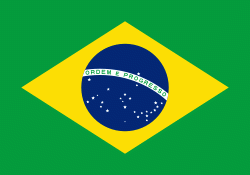Balneário Camboriú (Balneário Camboriú)
 |
 |
In a story published in late February 2012 by Forbes magazine about the ascent of electronic music in Brazil, Balneário Camboriú was presented as "the capital of e-music" in the country. According to Forbes, Balneário Camboriú is the home to the two best clubs in Brazil, the Warung club and the Green Valley club, which the publication claims to make up to $1.6 million per night. On 2012, the famous nightclub Space opened an affiliate in the city, the Space B. Camboriú. The city is also known by the nickname "Brazilian Dubai", due to its high number of skyscrapers and affluent tourists.
The city is served by Ministro Victor Konder International Airport located in the adjoining municipality of Navegantes.
Nobody knows for sure what the city's name means, but the most acceptable explanation, according to the city's archives, is "River filled with Snook (Robalo)", which is a very common type of fish in this region. Ilha das Cabras (Goats' Island) is directly opposite the city and is too small for inhabitation but is lit at night. Sailings to nearby Laranjeiras Beach take place aboard 17th century-style pirate ships, going around the island before returning to Balneário Camboriú again. The city also has a statue similar to the Cristo Redentor (Christ the Redeemer) in Rio de Janeiro, called Cristo Luz, but the one in Balneário Camboriú has small differences: it is a little smaller than Redeemer and it portrays Jesus with a "broad-brimmed hat" like circle on his left shoulder, symbolizing the Sun, which houses a spotlight that shines out to the entire city. The Cristo Luz is lit at night, also having colorful lights in its body that changes periodically. Another common sight in the city are paragliders over the beach, alongside the tall buildings, from the gliderport in nearby Praia dos Amores, located 1 km (0.6 mi) to the north of the city. To the west the city is bordered by the Camboriú River, which meets the ocean at the southernmost limit of the central portion of the city, where the cable car (teleférico) mentioned above is located.
The first inhabitants of the region were the indigenous Tupi-Guaraní tribe. Settlement began in 1758 when a few families from Porto Belo were established at the site known as Our Lady of Bon Sucesso later called Barra. In 1836, Thomas came to the place Francisco Garcia and his family and some slaves hence the former name of Garcia by which the village was known. Baltasar Pinto Corrêa from the Azores was the first settler followed by groups of Germans in search of fertile land in the region who were coming from the valley of the Itajal and Blumenau. They founded the town of Bom Sucesso and the site of the church of Our Lady of Good Success. In 1848 it became a district of the city of Itajaí. In 1836, Thomas came to the place Francisco Garcia and his family and some slaves. Hence the former name of Garcia, which the village was known. In 1884 the town was detached from the city of Itajaí. In 1930, the privileged geographical location, it started phase of occupation of the region preferred by swimmers and, two years later, built the first hotel, at the confluence of the central and Atlantic avenues. In 1964, the district earned autonomy, to commune with the toponymy of Balneario de Camboriu, amended in 1979 to Balneario Camboriu.
There are two versions about the origin of toponymy Camboriu. One of popular origin, due to a sharp bend in the river near the mouth, says, when asked by someone looking for a person, the residents there said "Camba the river," word much used by fishermen in the region. The second version (and more acceptable) is the priest Raulin Reitz: maps and old indicate the name Rio Camboriu there before European settlement in the area of origin, the toponymy Camboriú comes from Tupi, formed by the agglutination of the words: Camboriu-u.
Map - Balneário Camboriú (Balneário Camboriú)
Map
Country - Brazil
Currency / Language
| ISO | Currency | Symbol | Significant figures |
|---|---|---|---|
| BRL | Brazilian real | R$ | 2 |
| ISO | Language |
|---|---|
| EN | English language |
| FR | French language |
| PT | Portuguese language |
| ES | Spanish language |


















